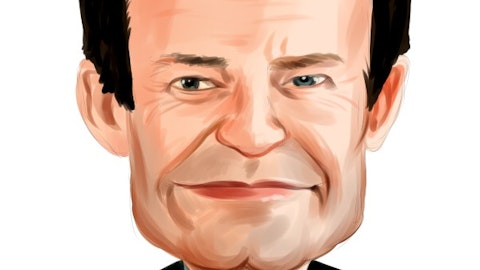Parker-Hannifin Corporation (NYSE:PH) Q2 2023 Earnings Call Transcript February 2, 2023
Operator: Good day, and thank you for standing by. Welcome to the Parker-Hannifin Corporation’s Fiscal 2023 Second Quarter Conference Call and Webcast. At this time, all participants are in a listen-only mode. After the speakers’ presentation, there will be a question-and-answer session. Please be advised that today’s conference is being recorded. And I would now like to hand the conference over to your speaker today, Mr. Todd Leombruno, Chief Financial Officer. Sir, please go ahead.
Todd Leombruno: Thank you, Chris. Good morning, everyone, and thank you for joining Parker’s fiscal year 2023 Q2 earnings release webcast. As Chris said, this is Todd Leombruno, Chief Financial Officer speaking. And joining me today is Jenny Parmentier, our Chief Executive Officer; and Lee Banks, our Vice Chairman and President. Our second quarter results were released this morning and before we get started, I just want to remind everyone, we will be addressing forward projections and non-GAAP financial measures. Slide 2 of this presentation details our disclosures our disclosure statement to issues in these areas. These forward-looking statements detailed issues that could make actual results vary from our projections. Our press release, this presentation and all reconciliations for non-GAAP measures are now available under the Investors section at parker.com and will remain available for 1 year.
We’re going to start the call today with Jenny addressing some focus areas for the company as she takes on the role of CEO. She will then address some highlights for the quarter, which we just released this morning, and then I’ll follow up with a brief financial summary and then review the increase to our FY ’23 guidance that we issued this morning. Jenny is going to wrap up with a few summary comments. And then Jenny, Lee and I will take as many of your questions as possible. I now ask you to reference Slide 3. And Jenny, I will hand it over to you.
Jennifer Parmentier: Thank you, Todd. Good morning to everyone, and thank you for joining the call today. As Todd said, before we get into the quarter results, I’d like to remind everyone what drives Parker and give you some insight on where we’ll be focusing. Moving to Slide 2. New CEO, same three drivers: living up to our purpose, continuing to be great generators and deployers of cash and achieving top-quartile performance versus our proxy peers. Slide 3, please. Safety, purpose and engagement are the foundation of top quartile performance. As I mentioned to all of you in the December call, we are committed to delivering the Meggitt cost synergies of $300 million, and we’re very pleased with the progress to date. We’ve said before, it’s still early innings for Win Strategy 3.0, and we will continue to utilize it to accelerate our performance.
Our culture is one of continuous improvement as evidenced by past performance and results we will deliver well into the future. And we are fully committed to achieving our FY ’27 targets that we rolled out at Investor Day last March. All of this will allow us to continue with the transformation and ensure a very promising future for Parker. Moving to Slide 4, please. You’ve seen this before, Parker has a proven strategy. The Win Strategy is and will remain our business system. It is a system focused on the fundamentals. We trust the process, and we’ll continue to get results from it as we have in the past. Slide 5, please. So where will Win Strategy 3.0 accelerate our performance? Well, it always starts with our people. Safety number 1 and it always will be.
Our goal is zero incidents, and we believe it is possible. We brought a lot of new people into the business over the last couple of years, and we have the opportunity to double down on the training and chartering of high-performance teams and leaders. This will further strengthen our culture of continuous improvement and our brand of Kaizen well into the future. Moving over to customer experience. We have an opportunity to do even better with the digital customer experience. Anywhere from how we interact with our customers on quotes and orders, to the availability of digital products and the use of artificial intelligence for demand forecasting with both our customers and our suppliers. It’s early days for our zero defect initiative as well.
This obviously drives better quality and overall customer satisfaction. This is the exact same approach that we took with zero safety incidents. Zero defects is possible. It starts with engaging our people around robust products and capable processes. Doing this right exposes the hidden factory, improves quality, reduces cost and thus expand margin. Best-in-class lead times have been part of our Win Strategy for many years. And coming out of the pandemic and subsequent increase in volume, we see even more opportunities to improve lead times and become supply chain leaders. Our customers deserve this level of service and all of these are strong enablers of growth. Profitable growth is a combination of performance and portfolio changes, which we have demonstrated.
Strategic positioning is a tool used by our general managers to segment their business and position them best in their markets and with their customers. This process and cadence will continue to drive the critical thinking about growth in the division and closest to the customer. We are obviously seeing the benefits of the transformed portfolio, and we will continue to seek out those opportunities that will enhance the transformation. The most significant CapEx spending in decades will bring growth to Parker with all the technologies we have supporting the secular trends today and for many years to come. And we have an annual cash incentive plan, which incentivizes the right behaviors and drives a real intensity around growth. Moving over to financial performance.
We have a proven set of simplification tools, which will continue to help us reduce complexity and cost. House in this area is our simple by design process, which you’ve heard us talk about a lot. This has become a fundamental — a business fundamental across the Corporation. We have a robust process around value pricing, and we’ll continue to strive for margin neutrality in these inflationary times. We will also double down on training the principles of lean. This is the foundation of our continuous improvement culture and it drives safety and productivity in all of our operations. You’ve heard us say many times over the past few years that while not immune to the chaos of the supply chain, we fared better than others due to our dual sourcing initiatives and our local-for-local strategy.
The pandemic and subsequent increase in volume exposed some areas that we can further improve upon to ensure that we become supply chain leaders. Our teams are looking to further enhance the visibility of the changing demand picture and utilize some new scheduling tools that will drive efficiency in the operations and those best-in-class lead times that I just mentioned. Focusing on these areas and Win Strategy 3.0 will help us to achieve top quartile performance. Slide 6, please. Our capital deployment priorities remain unchanged. We will maintain our record on dividend payouts and target a 5-year average payout of 30% to 35% net income. We will target 2% of sales on CapEx to fund organic growth and productivity. The 10b5-1 share repurchase program will remain in place and our near-term and top priority is to delever post the Meggitt acquisition.
We will keep our acquisition pipeline healthy and we’ll continue to build relationships for future acquisitions. Slide 7, please. So Q2 was another quarter of excellent operating performance. We saw a 16% reduction in safety incidents versus prior year, further supporting our ability to reach zero incidents. Sales came in at $4.7 billion, a 22% increase to prior with organic growth coming in at 10%. Strong segment operating margin across all segments has led us to a full year guidance increase and we are very happy with the progress of the Meggitt integration. All activities and synergies are on schedule. Moving to Slide 8. We’d like to share some recent highlights on the integration. Key leaders from both Parker and Meggitt are leading over 20 teams that are creating a lot of value in integrating the functions.
Engagement with the team members and the customers that had widespread activity in all locations and wind strategy training and implementation is well underway. Just to note here, we have a proven track record of delivering synergy targets, and this acquisition will be the same. The teams are following the integration playbook that has been developed over the last several acquisitions, and I am sure they will add some new best practices to it as well. Slide #9. So we are on track to achieve the $60 million in synergies by the end of this fiscal year, and the graph on the left illustrates our path to $300 million in synergies and adjusted EBITDA margins of 30% by FY ’26. Synergies are represented in blue and the cumulative costs to achieve are in gold.
On the right side of this page, this quadrant depicts the use of the overall Win Strategy to achieve the synergies and ensure operational excellence into the future. Starting with the top left, Safety, Lean, Kaizen, high-performance teams all make up our brand of Kaizen and will drive the engagement and continuous improvement well into the future. Simplification is a major area of focus for the integration teams. This is where we look at structure and org design. We use our 80-20 complexity reduction tool, and we implement simple by design principles. All of this drives real ownership and decision-making at the division level, further empowering the team to drive results. Moving over to SG&A. We’ve had the realization that there’s a lot of opportunity moving Meggitt from a centralized structure to Parker’s decentralized structure, driving that overall decision-making to the local level and improving overall speed.
With this acquisition, footprint optimization is very minor. Remember, we have complementary technologies with this acquisition and not a lot of overlap at the plant level. And with supply chain will optimize pricing, terms and conditions, direct and indirect material spend as well as logistics. Again, off to a great start, very pleased with the performance on quarter end. And now I’ll turn it back to Todd for a summary of our Q2 results.

Photo by Ibrahim Boran on Unsplash
Todd Leombruno: Thanks, Jenny. That was great. Okay. So I’m going to begin on Slide 12 with the financial results. I can’t tell you how excited the team is. This is the first full quarter that includes Meggitt in our results. It also is the first full quarter that we do not have Aircraft Wheel and Brake in our results. So the year-over-year comparisons are a little bit more complicated than usual. But you see the top line sales increased 22% versus prior year. That clearly is a record for us at $4.7 billion. Organic growth continues to be extremely healthy and was just over 10% in the quarter. That does extend our string of double-digit organic growth quarters. Although better than forecasted, the currency headwinds do continue.
The currency impact to sales was unfavorable by 4% in the quarter versus prior year. And when you look at the net of the Meggitt acquisition and the Aircraft Wheel and Brake divestiture, that was a positive 16% to our sales in the quarter. Looking at adjusted segment operating margin, we exceeded our forecast, and we finished at 21.5%. And if you look at adjusted EBITDA margins, that was even stronger at 22.4%. And just as a reminder, we mentioned this last quarter, we do expect Meggitt to be just slightly dilutive to overall margins in this first sub-years as we generate those synergies that Jenny just spoke to. Looking at adjusted net income, we did $619 million or 13.2% ROS. That is an improvement of 6% versus prior year, and adjusted earnings per share were $4.76.
That’s a Q2 record and an increase of $0.30 or 7% compared to the prior year. Overall for Q3, we are extremely happy to have that first quarter of Meggitt in the books to see that sales increase by 22% and obviously, see the positive net income and EPS growth. So just really happy with the results of the quarter. If we jump to Slide 13. This is just going to be the visual elements of that $0.30 EPS improvement. And again, I’m really happy to say the driver of this is the additional segment operating income. We generated $180 million or 22% additional segment operating income versus the prior year. If you look at that, that added $1.8 to EPS for the quarter. Interest expense, as expected, is a headwind. It’s a $0.51 headwind. That was a little bit higher than we were expecting just with the movement in rates, 100% of that entire $0.51 is related to the Meggitt transaction and what’s going on in the rate environment.
Other expense was $0.12 unfavorable. That was primarily driven by year-over-year changes in currency rates and income tax is a drag of $0.14, really because last year benefited from a number of discrete items that were favorable. And of course, this year, we have some of these transaction costs in the quarter that are not deductible. Everything else nets to just $0.01. And if you look at all those items, that makes up our $0.30 increase to that record $4.76 earnings per share, and we’re really happy with that. If you jump to Slide 14 and just looking at the segments, once again, every segment was positive organic growth in the quarter. We exceeded our margins across the board. Every segment exceeded our expectations on margins. Orders remain positive despite some pretty tough comps in the prior year and for the total company finished at plus 3.
And really, demand does remain robust across all the markets we serve. Our team members really are working hard to meet customer expectations. And the result is that record sales that we just generated in the second quarter. If you look specifically at the North American businesses, Sales are extremely strong at $2.1 billion. Organic growth in that segment is 13.5%. Adjusted operating margins did increase 50 basis points in North America. They finished at 21.8%, that is a record and just really healthy volumes and a gradually improving supply chain really helped drive performance in those North American businesses. Order rates are positive at plus 2 and that really matches our strong backlog and really that broad-based demand that is consistent across North America.
So special thanks to our team members in North America for their record performance. Looking at the international businesses, sales were $1.4 billion. Organic growth there, almost 9% from prior year. And across all of our regions in the International segment, we were positive from an organic growth standpoint. Margins remained high at 21.9%. This is slightly down from prior year, really due to currency, a little bit of product mix and some China COVID-related headwinds, just specifically in China. Order rates are minus 4. They were positive last quarter, but that did have a bit of a rebound, if you remember, from the COVID-related shutdowns in China. So we’re watching that very closely. Aerospace Systems, obviously, huge sales, up 84%. They did exceed $1 billion for the first time, and that obviously is clearly driven by the addition of the Meggitt businesses in our Aerospace Systems segment.
Organic growth in aerospace was almost 5%. Really strong OEM and MRO commercial activity in that segment, both from sales and orders being mid-teen positive on the OEM side of it and military OEM remains negative as we expected. Operating margins were 20.6% in that segment. That is up 70 basis points from last quarter and better than we forecasted. And really, the Meggitt integration, the performance of the businesses, the synergies, like Jenny had mentioned, totally on track, and we’re really happy with that. When you look at aerospace orders, they are plus 22. We talked for the last couple of quarters about that bad comp we had with the military orders we’ve now — we’ve passed that comp. So you can see the orders are 22%. We’re really happy with that.
Great performance across all of the businesses this quarter. Great job, everyone. If we go to Slide 15, this is just cash flow. This is our performance on a year-to-date basis. The Meggitt transaction, we’ve talked about this last quarter, there’s a drag to cash flow just based on some of those transactions costs. They did impact CFOA and free cash flow by roughly 2%. But even excluding that, if you look at the numbers as reported, cash flow from operations is 12.1% of sales. We did surpass $1 billion in cash flow from operations on a year-to-date basis and our free cash flow is 10% of sales. Our CapEx, as we have communicated, just slightly over 2% for the year, and free cash flow conversion is 114%. I think everyone knows us pretty well. Our cash flow is always second half weighted and we continue to forecast mid-teens cash flow from operations, and certainly, free cash flow conversion over 100% for the full year.
If we jump to Slide 16, just a few comments on capital deployment. I think everyone saw that last week, our Board approved a quarterly dividend payout of $1.33 per share. That is our 291st consecutive quarterly dividend, and it is certainly in line with those targets that Jenny mentioned earlier. On leverage, we did make progress on reducing our leverage. If you look at gross debt to adjusted EBITDA, that was 3.6. Net debt to adjusted EBITDA was 3.4. Both of those metrics improved 0.2 turns from Q1. So that EBITDA is on a trailing 12-month basis. And just a reminder, that only includes Meggitt EBITDA from the date of close, so roughly 3.5 months of Meggitt EBITDA. And I’m proud to say we’ve now applied over $2.2 billion of cash towards that Meggitt transaction.
And we’re really fully committed to our deleveraging plan, and that plan remains on track. So good progress there. Okay. So moving to guidance on Slide 17. You saw we did increase our guidance this morning. We are providing this as usual, on an as reported and on an adjusted basis. And if you look at the sales range, we are increasing that. We’re increasing the range from 14.5 to 16.5 or from, excuse me, 14.5 to 16.5 or 15.5% at the midpoint. More importantly, organic growth, if you look at our organic growth for the full year, we are increasing that to 7%. That is up 1% from 6% last quarter. The impact of acquisitions and divestitures. We’re moving that up just slightly to 11.5%. That was 11% last quarter. And while currency is still a headwind, we expect that to be less bad.
We now forecast that to be a 3% impact to sales, negative. And that’s down from what we were forecasting last quarter at negative 4.5 and that is using spot rates as of December 31 like we normally do. When you look at adjusted segment operating margins for the full year, we are increasing that full year guide by 20 basis points to 22.1%, and that is at the midpoint, there’s a range of 20 basis points on either side of that. And just a few additional items to note. If you look at interest expense, that is now up to $555 million. That was $510 million last quarter. That does include the changes in the interest rates that just were announced yesterday and really what we forecast them to do in the upcoming months. Corporate G&A is $204 million and other income is really an income of $18 million.
Both of those numbers are virtually unchanged from our prior guide. If you look at our tax rate, just based on where we’re at now, halfway through the year, we believe that will be 23.5% for the full year. And adjusted EPS is now raised to $19.45, that’s a $0.50 increase from our prior guide and there is a range around that or plus or minus $0.25. Specifically, for Q3, organic growth is expected to be nearly 4%. We raised that from our prior guide and adjusted EPS is expected to be at the midpoint. And finally, adjustments in the forecast at a pre-tax level are listed here on this table for the remainder of the year, together with acquisition-related expenses incurred to date. So that’s the details on guidance. If you go to Slide 18, this is again just a little bridge on that.
You can see where we start. Our prior guide was $18.95, that strong performance in Q2. We’re rolling in that $0.45 beat. We are increasing segment operating income by $0.35 for the remainder of the second half. And I just wanted to note that $0.25 of that is due to the less bad currency rates. If you remember last quarter, we knocked that down a little bit based on where rates were at the end of September. We’ve now moved that back a little bit, and there’s a little bit more based on the organic growth increases, and that is $0.35. Interest and tax still continue to be a bit of a headwind. You can see the interest expense is a $0.20 headwind and income tax for the second half of the year is just $0.10. Add it all together, we get to $19.45 at the midpoint, and that is the changes to our guidance.
So with that slide, I will ask you to focus on Slide 19. And Jenny, I will hand it back over to you for summary comments before we go to Q&A.
Jennifer Parmentier: Thank you, Todd. So we have a very promising future. We have a highly engaged team that’s living up to its purpose. We’ll continue to accelerate our performance with Win Strategy 3.0. We are seeing the benefit of our strategic portfolio transformation, and we will continue to be great generators and deployers of cash. And with that, Chris, I think we’re ready for questions.
See also 10 Most Undervalued Tech Stocks To Buy and 15 Biggest Neuroscience Companies in the World.
Q&A Session
Follow Parker Hannifin Corp (NYSE:PH)
Follow Parker Hannifin Corp (NYSE:PH)
Operator: And one moment for our first question. Our first question will come from Jamie Cook of Credit Suisse.
Jamie Cook: Nice quarter. I guess two questions. One, can you give a little more color on the negative order growth in international and then the acceleration that you saw in orders in the Aerospace segment? That would be helpful. And then, Jenny, I guess, just a bigger question for you today. Obviously, Parker has been on a journey to move their — through acquisitions, move their portfolio into higher value-add services, higher organic growth businesses, but it’s been more really about acquisitions versus divestitures. I guess as you look at the portfolio today, do you still see Parker going down the path of looking at acquisitions? Or is there an opportunity to look at potential businesses that might not make sense for Parker over the longer term?
Jennifer Parmentier: Thanks, Jamie. I’ll try to answer your second question, and then I’m going to let Lee give some color on your first question. So we always want to be the best owner of any business, right? So we have a regular process where we look at that every year. So that’s something that’s well in place, and we’ll continue to do that. As we look to future acquisitions, again, we’re going to be looking for the type of acquisition that is margin accretive. It has that resilience of a longer-cycle business and something that fits well with Parker. So obviously, short term, we need to pay down some debt for Meggitt, but that’s why it’s important for us to keep those relationships strong for the future.
Lee Banks: Jamie, it’s Lee. Just commenting on international orders. The biggest story here is really Asia Pacific, and it’s really around China. If you think about where we’ve been, I mean, we’ve had consistent COVID lockdowns, start-stop, and then really tight monitoring fiscal restraint by the government trying to get some of the real estate markets under control, et cetera. And we saw really that really play out specifically later in the quarter, things contracting and slowing down. The other thing quite frankly, the Chinese New Year is the first time in almost three years, the Chinese New Year has really been fully open. So the amount of people traveling and gone is a lot different than it’s been in the past. Having said that, we’re conservatively optimistic going on the second half of the year.
I’m seeing low single — flat to low single-digit positive growth in Asia Pacific, really led by China. The — I think it’s still going to be a little troublesome in China as they get their supply chains up and running, et cetera. But I’d like to believe that with the stimulus going in and everything else that we’re going to see some positive momentum there.
Jamie Cook: Okay. And then color on aerospace, is it just all commercial, I presume?
Lee Banks: Yes. The big thing, aerospace was really the military OEM orders lapping. So we had some big pull forwards orders and then we’ve lapped that on that 12, 12 basis. So you’re seeing the positive order entry rate in commercial OEM and commercial MRO right now.
Operator: Thank you. One moment please for our next question. Next question will come from Andrew Obin of Bank of America.
Andrew Obin: Yes. No, it’s a pleasure not to be restricted. Yes, just more of a longer-term question. So a couple of companies are sort of talking about managing the operations, managing the backlog differently in this environment, maybe sort of accepting that lead times are going to be extended for a while, right, given that at the tail, there’s still a lot of disruption in the supply chain. Are you guys thinking about sort of structurally adjusting your view on lead times? How much backlog Parker carries into the future? Just any insight would be super helpful.





